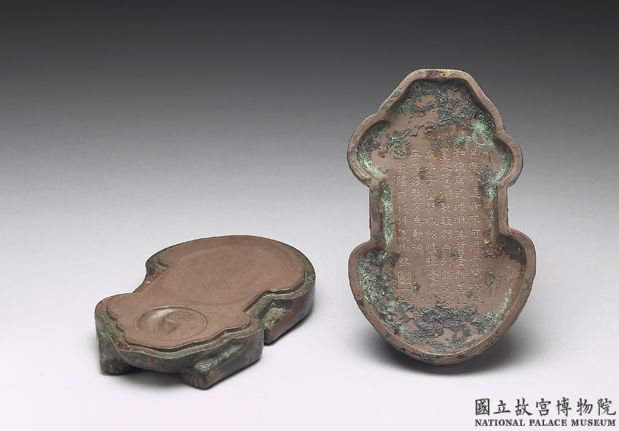Imitation of refined clay inkstone shaped like a reclining tiger, Qing dynasty, Qianlong reign (1736-1795)
- Image Number: K1F000542N000000000PAD
- Dynasty: Qing dynasty
- Category: Studio implements
- Function: Stationery
- Material: Minerals/Ceramics/
- Description:
The whole piece is shaped like a crouching tiger. It is brown and purple in color. The surface of the piece is covered with the green rust color of antique bronze ware. The surface of the inkstone has fine edges along the edges, and the edge of the cover is raised to fit the inkstone body. The ink pool is in the shape of Tai Chi, and the ink hall is slightly concave. The inkstone covers the tiger’s head with two small ears slightly pointed, and the eyes are high and protruding, with a slightly cat like appearance. Inside the cover, there is an inscription inscribed in the official script of the Qing Dynasty: “It is impossible to obtain the inscription made by Lao Lu; Jinchang is forged skillfully, like a crouching tiger, with its quality and green color; it is difficult to distinguish white from the old side; it is listed in the study, and you are like a child; after a few moments of leisure, you can feel happy, and your strokes are north; every procession of mastiff is not without shame.” Paragraph: “In the midsummer of Qianlong’s 1898, the imperial inscription”, with the seals: “Bi De”, “Lang Run”. This inkstone was included in Page 34-37, Page 23 of the Western Qing Inkstone Manual. When the book was completed, it was stored in Wenyuan Pavilion. As far as the archaeological unearthed data are concerned, this kind of inkstone is similar to the shape of foreign animals’ copper inkstone boxes in Han inkstones. One kind of Han inkstone objects unearthed in archaeology can be classified into board research, but the inkstone is stored in the copper foreign animals’ inkstone boxes. As far as we know, there are two cases. One is unearthed in Feidong County, Anhui Province in 1957. The foreign animals lie in a crouching state, with two horns at the head, two wings at the waist, and red and blue beads embedded in the whole body, Two eyes are inlaid with light green material decoration, with overall height of 6.5, height of 3, and length of 12.5 cm; The other one was unearthed in 1970 in the Tushan Tomb in Xuzhou, Jiangsu Province. The shape of the bronze alien animal is similar to the former, but the device is large (25 long, 14.8 wide, 0.5 cm high). It is gilded and inlaid with coral, turquoise, lapis lazuli and other secondary gemstones. The Hufu inkstone style is a kind of attached works influenced by inkstone boxes of the Han Dynasty. The Emperor Gaozong of the Qing Dynasty had read the Jia Clan’s Tale written by Zhang Ji in the early Southern Tang and Song Dynasties about the way people in Jiangxian County of Shanxi collected Chengni. After the first use of Chengni inkstone in the palace in the fortieth year of Qianlong’s reign (1775), it was a great reward. So he ordered Ba Yansan, the governor of Shanxi at that time, to pay close attention to the search, and the next year he obtained Chengni inkstone materials in Fenshui. Although the inkstone materials were obtained in Jiangxian County, there was no craftsman to burn Chengni inkstone in Jiangxian County at that time, so it was sent to Suzhou for development. From this Chengni Tiger Fu inkstone, it can be seen that at least in the 43rd year of Qianlong’s reign, “Wuzhong Craftsman” was able to “imitate and enter the imperial court”.

![图片[2]-Imitation of refined clay inkstone shaped like a reclining tiger, Qing dynasty, Qianlong reign (1736-1795)-China Archive](https://chinaarchive.net/Qing dynasty/Studio implements/K1F000542N000000000PAD-80171.jpg)
![图片[3]-Imitation of refined clay inkstone shaped like a reclining tiger, Qing dynasty, Qianlong reign (1736-1795)-China Archive](https://chinaarchive.net/Qing dynasty/Studio implements/K1F000542N000000000PAD-80172.jpg)
Pictures & Images [HD] download
© Copyright
The copyright of the article belongs to the author, please keep the original link for reprinting.
THE END





![[Qing Dynasty] British female painter—Elizabeth Keith, using woodblock prints to record China from the late Qing Dynasty to the early Republic of China—1915-China Archive](https://chinaarchive.net/wp-content/uploads/2022/11/image-191x300.png)